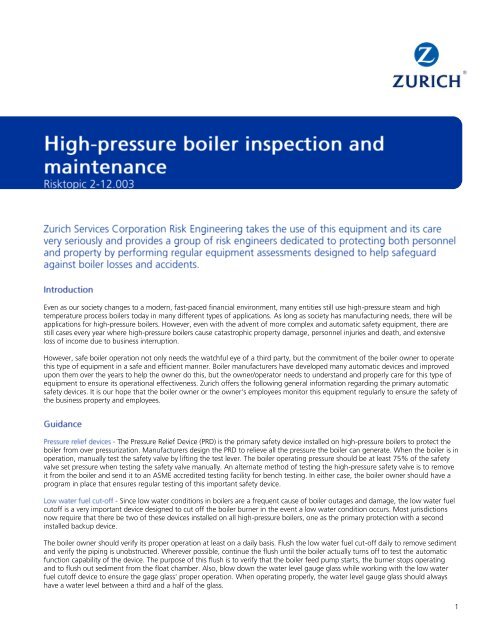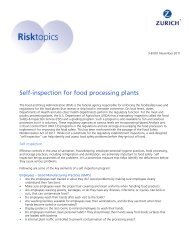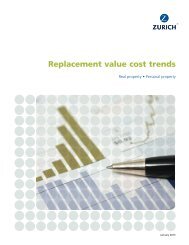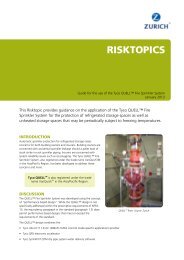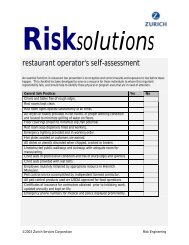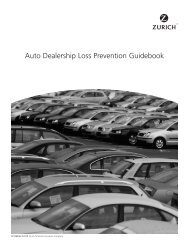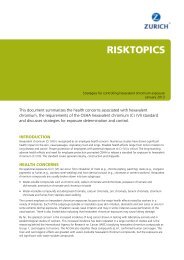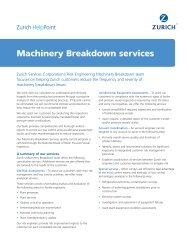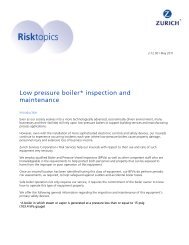high pressure boiler inspection and maintenance - Risk Engineering
high pressure boiler inspection and maintenance - Risk Engineering
high pressure boiler inspection and maintenance - Risk Engineering
Create successful ePaper yourself
Turn your PDF publications into a flip-book with our unique Google optimized e-Paper software.
Even as our society changes to a modern, fast-paced financial environment, many entities still use <strong>high</strong>-<strong>pressure</strong> steam <strong>and</strong> <strong>high</strong>temperature process <strong>boiler</strong>s today in many different types of applications. As long as society has manufacturing needs, there will beapplications for <strong>high</strong>-<strong>pressure</strong> <strong>boiler</strong>s. However, even with the advent of more complex <strong>and</strong> automatic safety equipment, there arestill cases every year where <strong>high</strong>-<strong>pressure</strong> <strong>boiler</strong>s cause catastrophic property damage, personnel injuries <strong>and</strong> death, <strong>and</strong> extensiveloss of income due to business interruption.However, safe <strong>boiler</strong> operation not only needs the watchful eye of a third party, but the commitment of the <strong>boiler</strong> owner to operatethis type of equipment in a safe <strong>and</strong> efficient manner. Boiler manufacturers have developed many automatic devices <strong>and</strong> improvedupon them over the years to help the owner do this, but the owner/operator needs to underst<strong>and</strong> <strong>and</strong> properly care for this type ofequipment to ensure its operational effectiveness. Zurich offers the following general information regarding the primary automaticsafety devices. It is our hope that the <strong>boiler</strong> owner or the owner's employees monitor this equipment regularly to ensure the safety ofthe business property <strong>and</strong> employees.The Pressure Relief Device (PRD) is the primary safety device installed on <strong>high</strong>-<strong>pressure</strong> <strong>boiler</strong>s to protect the<strong>boiler</strong> from over pressurization. Manufacturers design the PRD to relieve all the <strong>pressure</strong> the <strong>boiler</strong> can generate. When the <strong>boiler</strong> is inoperation, manually test the safety valve by lifting the test lever. The <strong>boiler</strong> operating <strong>pressure</strong> should be at least 75% of the safetyvalve set <strong>pressure</strong> when testing the safety valve manually. An alternate method of testing the <strong>high</strong>-<strong>pressure</strong> safety valve is to removeit from the <strong>boiler</strong> <strong>and</strong> send it to an ASME accredited testing facility for bench testing. In either case, the <strong>boiler</strong> owner should have aprogram in place that ensures regular testing of this important safety device.Since low water conditions in <strong>boiler</strong>s are a frequent cause of <strong>boiler</strong> outages <strong>and</strong> damage, the low water fuelcutoff is a very important device designed to cut off the <strong>boiler</strong> burner in the event a low water condition occurs. Most jurisdictionsnow require that there be two of these devices installed on all <strong>high</strong>-<strong>pressure</strong> <strong>boiler</strong>s, one as the primary protection with a secondinstalled backup device.The <strong>boiler</strong> owner should verify its proper operation at least on a daily basis. Flush the low water fuel cut-off daily to remove sediment<strong>and</strong> verify the piping is unobstructed. Wherever possible, continue the flush until the <strong>boiler</strong> actually turns off to test the automaticfunction capability of the device. The purpose of this flush is to verify that the <strong>boiler</strong> feed pump starts, the burner stops operating<strong>and</strong> to flush out sediment from the float chamber. Also, blow down the water level gauge glass while working with the low waterfuel cutoff device to ensure the gage glass' proper operation. When operating properly, the water level gauge glass should alwayshave a water level between a third <strong>and</strong> a half of the glass.1
- To prevent <strong>boiler</strong> fireside explosions, the <strong>boiler</strong> owner/operator must verify that some typeof flame-sensing device is in use to ensure that flame conditions are safe on the <strong>boiler</strong> burner side. In the event of flame failureduring operation, the flame-sensing device must be capable of stopping the <strong>boiler</strong> fuel supply, initiating an alarm <strong>and</strong> causing an airpurge of the <strong>boiler</strong> fireside passes to remove latent fuel fumes from the <strong>boiler</strong>'s firesides.Check the burner operation <strong>and</strong> flame pattern daily while checking the flame failure scanner periodically, preferably at least weekly.In general, listen for unusual noise, check for fuel leaks, check the position of dampers, <strong>and</strong> look or smell for indications of flue gasleakage. Observe the <strong>boiler</strong> stack temperature to verify the <strong>boiler</strong> exhaust temperature is within its normal operating range. Followthe manufacturer’s guidelines <strong>and</strong> the ASME CSD-1 Code for burner <strong>maintenance</strong> <strong>and</strong> testing of the flame failure scanner. If theburner shows any indications of abnormal operation, contact your <strong>boiler</strong> repair contractor.Each type of <strong>boiler</strong>, whether <strong>high</strong>-<strong>pressure</strong> steam or <strong>high</strong>-temperature fluid, will have <strong>high</strong> limit controlsinstalled. These devices will act as a backup control to the normal operating controls. On a <strong>high</strong>-<strong>pressure</strong> steam <strong>boiler</strong>, there will bean operating limit switch set to have the <strong>boiler</strong> burner fire when <strong>pressure</strong> drops to a set amount <strong>and</strong> then cut off when <strong>pressure</strong>reaches a set amount. If <strong>pressure</strong> exceeds the Normal Operating Pressure (NOP), or temperature in the case of a <strong>high</strong>-temperature<strong>boiler</strong>, the <strong>high</strong>-limit control switch is designed to send a signal to the <strong>boiler</strong> controls that will stop fuel flow <strong>and</strong> cut the <strong>boiler</strong> off,similar to the Flame Failure Scanner. Have a qualified <strong>boiler</strong> contractor test these devices during any normally scheduled <strong>maintenance</strong>period to ensure the proper signals are being conducted at the normal device setpoints.Not necessarily considered a safety device, the <strong>boiler</strong> blow-off valves are very important in helping to preventfuture problems with the <strong>boiler</strong>. The owner/operator uses the <strong>boiler</strong> blow-off valves to remove solids, sludge, <strong>and</strong> scale from the<strong>boiler</strong>. Consult your water treatment representative for the frequency <strong>and</strong> duration of the bottom blow-off. Open the quick openingvalve first, <strong>and</strong> then open the slow opening valve in order to warm up the blow-off piping. Always have a person observing the waterlevel glass when blowing down the <strong>boiler</strong>There are other devices used on <strong>high</strong>-<strong>pressure</strong> <strong>and</strong> <strong>high</strong>-temperature <strong>boiler</strong>s that are very important to the <strong>boiler</strong>'s safe <strong>and</strong> efficientoperation – temperature gauges, <strong>pressure</strong> gauges, fan controls, etc. to name a few. All of these devices have <strong>maintenance</strong>requirements that are just as important as the <strong>maintenance</strong> to the automatic safety devices <strong>and</strong> should be maintained just asrigorously to ensure proper <strong>boiler</strong> operation. Care for all of these devices should always be left to a fully qualified <strong>boiler</strong> contractor ormechanic trained in the operation <strong>and</strong> testing of <strong>high</strong>-<strong>pressure</strong> equipment.In addition, the <strong>boiler</strong> owner/operator should never hesitate to contact his assigned Zurich risk engineering consultant or the ZurichMachinery Breakdown Hotline at 800-562-5814 for any questions that may arise regarding the application of local <strong>boiler</strong> codes<strong>and</strong>/or safety rules enforced where the equipment is installed.1. National Board of Boiler & Pressure Vessel Inspector’s Code.2. ASME Boiler & Pressure Vessel Code, Section VI <strong>and</strong> CSD-1.3. McGraw Hill. Boiler Operator's Guide - Fourth Edition. Kohan, Anthony. 1998.2
Zurich Services Corporation<strong>Risk</strong> <strong>Engineering</strong>1400 American Lane, Schaumburg, Illinois 60196-1056800 982 5964 www.zurichna.comThe information in this publication was compiled by Zurich Services Corporation from sourcesbelieved to be reliable for informational purposes only. All sample policies <strong>and</strong> proceduresherein should serve as a guideline, which you can use to create your own policies <strong>and</strong>procedures. We trust that you will customize these samples to reflect your own operations<strong>and</strong> believe that these samples may serve as a helpful platform for this endeavor. Any <strong>and</strong> allinformation contained herein is not intended to constitute legal advice <strong>and</strong> accordingly, youshould consult with your own attorneys when developing programs <strong>and</strong> policies. We do notguarantee the accuracy of this information or any results <strong>and</strong> further assume no liability inconnection with this publication <strong>and</strong> sample policies <strong>and</strong> procedures, including anyinformation, methods or safety suggestions contained herein. Moreover, Zurich ServicesCorporation reminds you that this cannot be assumed to contain every acceptable safety <strong>and</strong>compliance procedure or that additional procedures might not be appropriate under thecircumstances The subject matter of this publication is not tied to any specific insuranceproduct nor will adopting these policies <strong>and</strong> procedures ensure coverage under any insurancepolicy.©2009, 2012 Zurich Services Corporation


